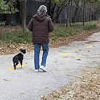How true-to-life is your dog training routine? Is your dog up to real world dog training? What happens when you’re in the middle of a 2-Minute training game and someone in the house starts banging pots in the kitchen? Or somebody opens the door, either leaving or coming home? Does your dog stick with the game and play with you? Or do they run off to see what the fuss is about?
It’s hard to focus on what you’re doing when somebody elsewhere may be more interesting. Dogs are really curious beings – they always want to be in the middle of the action. How do you get your dog to stick with what you’re doing, rather than run off to explore that odd sound in the other room?

The best answer is to set up the situation and teach your dog there’s nothing more interesting than playing training games with you. The harshest test we ever dealt with was many years ago in a puppy class. Our instructor stopped at a fast-food restaurant on the way to class. He threw fresh, yummy-smelling french fries all over the floor. And our job was to walk our puppies from one end of the room to the other – without the dogs grabbing a single morsel. We’re delighted to report that all the puppies succeeded. And, when that trial-by-fire was over, he allowed us to share a couple of fries with our good dogs.
Are you more interesting than a french fry?
If you’re not sure, it’s time to fill your dog training games with fun, energy, and really high-level rewards. If you use a bunch of different treats your dog loves, have a fresh batch of this “trail mix” handy. If your dog’s favorite reward is playing tug, stick a great tug toy in your pocket, ready to whip out at any moment. Randomize rewards so your dog never knows when the next one is coming.
Dogs love schedules and patterns and it’s easy to fall into habits in dog training. To pull an example from obedience competition – in the “Recall” exercise, when called, the dog runs to you from across the room and sits directly in front. When told or signaled, the dog then “Finishes” the exercise by going to heel position at your left side. There are two different ways for the dog to get there. He can either go to your right and circle behind you to get to heel. Or he can swing into position toward your left side.
The Finish always follows the Recall. Every single time. Which means that dogs, being smart, understand what’s coming next. And they “save you the trouble” and go right into heel position instead of stopping in front. Which, depending on the judge, can mean failing the exercise. So how do you fix it?
Randomize it! If dogs don’t know what’s coming next – they pay attention to what’s actually going on. Sometimes ask for the circle finish. Other times the swing. Still others, tell your dog to wait and go around them!
Embrace the chaos
Randomizing all the factors in dog training games ensures your dog can ignore distractions, focus on you and your game, and disregard outside influences. Ask your family to make weird, random noises from various rooms. And if, after a quick glance, your dog stays with your game, reward heavily – an instant game of tug, and series of high-value treats, a quick belly-rub/wrestling match.
Just like playing games in different locations cements the learning with your dog, working through various distractions will help them focus when you need them to. If your dog is incredibly distracted when the doorbell rings, get a doorbell app on your phone and play different rings during 2-Minute dog training game sessions. If it’s somebody talking on the phone that your dog can’t resist, ask someone to sit to the side during your game and talk into the phone (whether or not there’s someone on the other end).
Set your dog up with different scenarios you can practice in a controlled manner. If your dog is constantly underfoot when someone’s trying to prepare food in the kitchen, have a mat or bed in there and practice “place!” Create real world dog training dilemmas and help your dog deal with them.
No training bubble for you!
Your dog lives in the real world. Set her up for success by creating real-life situations and getting her to concentrate despite the distractions. It’s tempting to stay in an isolated environment where your dog is always perfect. But it’s like the first-time parents of a newborn infant insisting that everyone be quiet because the baby’s sleeping. Baby has to learn to sleep through all kinds of real world noise. And doggo has to learn to focus in the real world, too.
